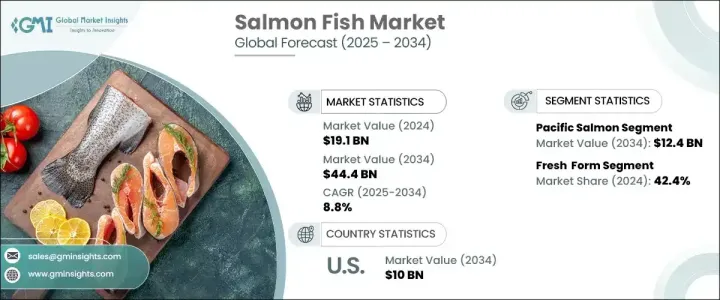
세계의 연어 시장은 2024년에 191억 달러에 이르렀으며, 2025-2034년 연평균 복합 성장률(CAGR) 8.8%로 확대될 것으로 예상됩니다.
특히 단백질과 오메가3 지방산을 풍부하게 포함한 영양가가 높은 고품질의 어패류에 대한 소비자의 기호의 고조가 큰 추진력이 되고 있습니다. 지속 가능성 또한 수산 양식의 진보를 뒷받침하는 핵심 초점이 되고 있습니다. 재순환형 양식 시스템 및 지속 가능한 사료 등의 기술은 환경에 미치는 영향을 줄이면서 생산을 보다 효율적으로 하고 있습니다. 그러나 남획, 서식지 파괴, 기후변화, 오염 등의 과제가 야생 개체군에 압력을 가해 생물 다양성 및 연어에 생존을 의존하고 있는 종에 영향을 주고 있습니다. 이러한 우려에도 불구하고, 양식에 있어서 기술 혁신 및 규제에 대한 대처는, 공급의 안정화와 세계 수요 증가에 대한 대응에 도움이 되고 있습니다.

종속별로 시장은 애틀랜틱 연어와 태평양 연어로 나뉘어져 있습니다. 애틀랜틱 연어는 고단백질과 오메가3 지방산을 포함하여 시장의 72.9%를 차지할 것으로 예측됩니다. 신흥 시장이 그 성장에 크게 기여할 것으로 예상됩니다. 한편 태평양 부문은 2024년 51억 달러로 평가되었으며, CAGR 9.2%로 2034년 124억 달러에 이를 것으로 예측됩니다. 뛰어난 맛과 영양가로 알려진 한편, 남획과 기후 변화가 천연 자원에 영향을 주고 있습니다.
| 시장 범위 | |
|---|---|
| 시작 연도 | 2024년 |
| 예측 연도 | 2025-2034년 |
| 시작 금액 | 191억 달러 |
| 예측 금액 | 444억 달러 |
| CAGR | 8.8% |
형태별로는 신선한 연어가 2024년에는 시장의 42.4%를 차지하였으며, CAGR 8.5%로 확대될 것으로 예측됩니다. 소비자는 영양가의 높이에서 신선한 제품을 선호하고 필레와 스테이크가 인기있는 선택지가 되고 있습니다. 냉동 부문은 보존 기간이 길고 편리성이 높기 때문에 CAGR 8.6%로 성장할 것으로 보이며 대규모 가공업자나 소매업체에게 선호되는 옵션이 되고 있습니다. 훈제 연어는 여전히 고급 제품이며, 특히 고소득 지역에서 강한 수요가 있습니다. 다양한 유형의 연어 통조림은 북미와 유럽에서 널리 받아들여지는 저렴한 옵션입니다. 연어알, 육포, 조리된 식품 등의 다른 형태는 고단백질 대체품을 요구하는 간편성에 중점을 둔 소비자를 수용합니다.
유통 채널별로는 신선, 냉동, 통조림 연어를 풍부하게 갖추고 있는 슈퍼마켓이 2024년에는 54.2%의 점유율을 차지했으며, 압도적인 존재가 될 것으로 예상됩니다. 편의점은 CAGR 9.5%로 성장하여 곧 먹을 수 있는 패키지 연어 제품 수요가 높아지고 있습니다. 2024년에 37억 달러로 평가된 온라인 소매는 정기 구매 모델과 대량 할인이 원동력이 되고, 2034년에는 85억 달러에 이를 것으로 예측됩니다.
미국은 여전히 주요 시장으로, 2024년의 추정 시장 규모는 51억 달러로 평가되었고, 2034년에는 100억 달러로 성장할 전망입니다. 양식 애틀랜틱 연어는 일년 내내 구할 수 있고 천연물에 비해 저렴하기 때문에 계속해서 인기를 끌고 있습니다. 생연어와 냉동연어의 출하량은 현저히 증가하고 있어 시장의 기세가 강함을 보여줍니다.
The Global Salmon Fish Market reached USD 19.1 billion in 2024 and is expected to expand at a CAGR of 8.8% from 2025 to 2034. Increasing consumer preference for nutritious, high-quality seafood, particularly rich in proteins and omega-3 fatty acids, is a major driver. Sustainability is also becoming a core focus, pushing advancements in aquaculture. Technologies such as recirculating aquaculture systems and sustainable feeds are making production more efficient while reducing environmental impact. However, challenges such as overfishing, habitat destruction, climate change, and pollution are putting pressure on wild populations, affecting biodiversity and species dependent on salmon for survival. Despite these concerns, innovations in farming and regulatory efforts are helping stabilize supply and meet rising global demand.

By species, the market is divided into Atlantic and Pacific salmon. The Atlantic segment is projected to hold 72.9% of the market due to its high protein and omega-3 content. Emerging markets are expected to contribute significantly to its growth. Meanwhile, the Pacific segment, valued at USD 5.1 billion in 2024, is forecasted to reach USD 12.4 billion by 2034, with a CAGR of 9.2%. While known for its superior taste and nutritional profile, overfishing and climate change are impacting wild stocks.
| Market Scope | |
|---|---|
| Start Year | 2024 |
| Forecast Year | 2025-2034 |
| Start Value | $19.1 Billion |
| Forecast Value | $44.4 Billion |
| CAGR | 8.8% |
By form, fresh salmon is anticipated to account for 42.4% of the market in 2024, expanding at a CAGR of 8.5%. Consumers prioritize fresh options for their nutritional value, with fillets and steaks being popular choices. The frozen segment is set to grow at a CAGR of 8.6% due to its extended shelf life and convenience, making it a preferred option for large-scale processors and retailers. Smoked salmon remains a premium product with strong demand, particularly in high-income regions. Canned salmon, available in various types, is a budget-friendly option widely accepted in North America and Europe. Other forms, including salmon roe, jerky, and ready-to-eat meals, cater to convenience-focused consumers seeking high-protein alternatives.
By distribution channel, supermarkets are expected to dominate with a 54.2% share in 2024, offering an extensive selection of fresh, frozen, and canned salmon. Convenience stores, growing at a CAGR of 9.5%, are seeing rising demand for ready-to-eat and packaged salmon products. Online retail, valued at USD 3.7 billion in 2024, is projected to reach USD 8.5 billion by 2034, driven by subscription models and bulk discounts.
The United States remains a key market, with an estimated value of USD 5.1 billion in 2024, set to grow to USD 10 billion by 2034. Farmed Atlantic salmon continues to gain traction due to its year-round availability and lower cost compared to wild-caught options. Shipments of fresh and frozen salmon have seen a notable increase, indicating strong market momentum.